GCE Chemistry A H032/01: Breadth in chemistry Advanced Subsidiary GCE Mark Scheme for November 2020
Document Content and Description Below
GCE Chemistry A H032/01: Breadth in chemistry Advanced Subsidiary GCE Mark Scheme for November 2020
Oxford Cambridge and RSA Examinations
GCE
Chemistry A
H032/01: Breadth in chemistry
Advanced Su
...
bsidiary GCE
Mark Scheme for November 2020Oxford Cambridge and RSA Examinations
OCR (Oxford Cambridge and RSA) is a leading UK awarding body, providing a wide range of
qualifications to meet the needs of candidates of all ages and abilities. OCR qualifications
include AS/A Levels, Diplomas, GCSEs, Cambridge Nationals, Cambridge Technicals,
Functional Skills, Key Skills, Entry Level qualifications, NVQs and vocational qualifications in
areas such as IT, business, languages, teaching/training, administration and secretarial skills.
It is also responsible for developing new specifications to meet national requirements and the
needs of students and teachers. OCR is a not-for-profit organisation; any surplus made is
invested back into the establishment to help towards the development of qualifications and
support, which keep pace with the changing needs of today’s society.
This mark scheme is published as an aid to teachers and students, to indicate the requirements
of the examination. It shows the basis on which marks were awarded by examiners. It does not
indicate the details of the discussions which took place at an examiners’ meeting before marking
commenced.
All examiners are instructed that alternative correct answers and unexpected approaches in
candidates’ scripts must be given marks that fairly reflect the relevant knowledge and skills
demonstrated.
Mark schemes should be read in conjunction with the published question papers and the report
on the examination.
© OCR 2020Annotations
Annotation Meaning
Correct response
Incorrect response
Omission mark
Benefit of doubt given
Contradiction
Rounding error
Error in number of significant figures
Error carried forward
Level 1
Level 2
Level 3
Benefit of doubt not given
Noted but no credit given
IgnoreAbbreviations, annotations and conventions used in the detailed Mark Scheme (to include abbreviations and subject-specific
conventions).
Annotation Meaning
DO NOT ALLOW Answers which are not worthy of credit
IGNORE Statements which are irrelevant
ALLOW Answers that can be accepted
( ) Words which are not essential to gain credit
__ Underlined words must be present in answer to score a mark
ECF Error carried forward
AW Alternative wording
ORA Or reverse argumentH032/01 Mark Scheme November 2020
SECTION A
Question Answer Marks AO
element Guidance
1 C 1 1.2
2 C 1 1.2
3 B 1 1.1
4 A 1 1.1
5 A 1 2.1
6 A 1 1.2
7 B 1 1.2
8 C 1 1.2 ALLOW 4
9 A 1 2.2
10 B 1 2.6
11 C 1 2.6
12 D 1 1.1
13 B 1 1.2 ALLOW 0.054(0)
14 A 1 1.2
15 C 1 1.1
16 C 1 1.1
17 A 1 1.2
18 C 1 2.8 ALLOW 36.7
19 B 1 1.2
20 C 1 2.6
Total 20H032/01 Mark Scheme November 2020
6
SECTION B
Question Answer Marks AO
element Guidance
21 (a) Shell 1st shell 2nd shell 3rd shell 4th shell
Electrons 2 8 18 32
Requires all 4 numbers to be correct
1 1.1
(b) Differences:
(Different number of) neutrons
Similarities:
(Same number of) protons AND electrons
2 1.1×2 IGNORE different masses/mass numbers
throughout
(Question asks for atomic structures)
ALLOW ‘amount’ for ‘number’
ALLOW ‘electron configuration’ for electrons
(c) (i) FIRST CHECK ANSWER ON THE ANSWER LINE
If answer = 35.48 (to 2 DP) award 2 marks
(35 × 75.76) + (37 × 24.24)
100 OR 35.4848 OR 35.485
= 35.48 (to 2 DP)
2 1.2×2
For 1 mark: ALLOW ECF → to 2 DP if:
• %s used with wrong isotopes ONCE
OR
• transposed decimal places for ONE %
AND
• calculated Ar is between 35 and 37
(c) (ii) m/z = 72: 35Cl37Cl
OR Contains chlorine-35 AND chlorine-37
m/z values: 70 AND 74
2 3.1
3.2H032/01 Mark Scheme November 2020
7
Question Answer Marks AO
element Guidance
22 (a) (i) (1s2)2s22p63s23p63d104s24p5
Look carefully at 1s22s22p63s23p6
– there may be a mistake
1 1.2 ALLOW 3d after 4s2,
e.g. 1s22s22p63s23p64s23d104p5
ALLOW upper case D, etc and subscripts,
e.g. …...4S23D1
DO NOT ALLOW [Ar] as shorthand for
1s22s22p63s23p6
IGNORE 1s2 repeated
(a) (ii) P4 + 6Br2 → 4PBr3 1 2.6 ALLOW multiples
(b) Giant ionic
In solid state/lattice,
ions are fixed (in position) OR cannot move
AND
In liquid state,
ions are mobile OR can move
2 1.1
1.2
‘Giant’ is essential
Mark independently of 1st structure mark
IGNORE comments about electrons for solid
IGNORE ‘free’ ionsH032/01 Mark Scheme November 2020
8
Question Answer Marks AO
element Guidance
(c) FIRST CHECK ANSWER LINES
If molecular formula = BrF5 AND 174.6/175 AND
working showing use of ideal gas equation
Award 5 marks for calculation
----------------------------------------------------------------------
Rearranging ideal gas equation
n =
pV
RT
Unit conversion AND substitution into n = pV
RT :
• R = 8.314 OR 8.31
• V = 76(.0) × 10–6 (m3)
• T in K: 373 K
e.g.
1.00 × 105 × 76.0 × 10–6
8.314 × 373
Calculation of n using p, V, R AND T
n = 2.45 × 10–3 (mol)
Calculation of M
M = 0.428
2.45 × 10–3 = 174.6
Molecular formula
BrF5 OR F5Br
5
2.2×4
3.2
ALLOW ECF throughout
IF n = pV
RT is omitted, ALLOW when values are
substituted into rearranged ideal gas equation.
ALLOW conversion of V into dm3 AND p in kPa
Gives same answer in powers of 10
Calculator value:
from 8.314 = 2.450725899 × 10–3
from 8.31 = 2.45190555 × 10–3
IGNORE figures after 5 in 2.45
ALLOW ECF from a value of n that has been
derived from pV = nRT
e.g. 0.174.6 OR 0.175 from 2.45
ALLOW ECF matching ECF M from pV = nRT
Use of
24 dm3
Final 2 marks possible for use of 76.0 cm3 OR 0.760 dm3 by ECF
e.g. n =
76.0
24000 = 3.17 × 10–3 No mark (calculation much simpler)
M = 0.428
3.17 × 10–3 = 135 ECF
BrF3 ECFH032/01 Mark Scheme November 2020
9
Question Answer Marks AO
element Guidance
23 (a) FIRST CHECK ANSWER ON THE ANSWER LINE
If answer = 0.454 (mol dm–3) award 3 marks
If answer = 0.227 (mol dm–3) award first 2 marks
----------------------------------------------------------------------
n(Ba(OH)2) in 100 cm3 1 mark
=
3.89
171.3 = 0.0227…. (mol)
3 SF or more
Concentration of OH– 2 marks
n(Ba(OH)2) ×2 = 2 × 0.0227
= 0.0454…. (mol)
Use of ×10 = 10 × 0.0454
Concentration of OH– = 0.454 (mol dm–3)
3 SF required
3
3.1×2
3.2
ALLOW ECF throughout
ALLOW use of 171 within working
(Use of Ar: Ba 137 rather than 137.3)
Calculator: 0.02270869819
IGNORE figures after 7 in 0.0227
ALLOW working with ×10 before ×2
Use of ×10 = 10 × 0.0227
= 0.227…. (mol)
Use of ×2 = 2 × 0.227
Concentration of OH– = 0.454 (mol dm–3)
3 SF required
Common error
0.227 no × 2 2 marks
(b) (i) (Titres that agree) within 0.1 cm3 1 2.3 ALLOW within 0.05 cm3
ALLOW ml for cm3
If cm3 units are absent, ASSUME cm3
BUT
DO NOT ALLOW incorrect units,
e.g. dm3; mol dm–3H032/01 Mark Scheme November 2020
10
Question Answer Marks AO
element Guidance
(b) (ii) FIRST CHECK ANSWER ON THE ANSWER LINE
If answer = 0.0856 (mol dm–3) award 3 marks
----------------------------------------------------------------------
n(HNO3) = 0.160 × 26.75
1000 = 4.28 × 10–3 (mol)
n(Ba(OH)2) in 25.0 cm3 = 4.28 × 10–3
2
= 2.14 × 10–3 (mol)
Concentration = 2.14 × 10–3 × 1000
25
= 0.0856 (mol dm–3)
3
2.8×2
2.4
Use ECF throughout
DO NOT ALLOW 4.3 × 10–3
BUT remaining marks available by ECF
e.g.
4.3 × 10–3 ÷ 2 = 2.15 × 10–3 ECF
2.15 × 10–3 × 1000
25 = 0.086 ECF
(c) Route 1
Reactant:
Add water (to Ba) OR H2O in equation
Balanced equation:
Ba + 2H2O → Ba(OH)2 + H2
Route 2
Balanced equation with O2
2Ba + O2 → 2BaO
Balanced equation with H2O
BaO + H2O → Ba(OH)2
4
3.3
2.6
3.3
3.3
ALLOW multiples in equations
Balanced equation automatically collects 2
marks for Route 1
ALLOW 1 mark for BOTH reactants in route 2:
i.e. React with O2 AND then with H2O
NOTE
3 correct balanced equations → 4 marksH032/01 Mark Scheme November 2020
11
Question Answer Marks AO
element Guidance
24 (a) FIRST CHECK THE ANSWER ON ANSWER LINE
If answer = –46 (kJ mol–1) award 3 marks
Use of ∆cH values and balancing numbers
± (+180 + (3 × –286)) OR ± 678
AND
± (2 × –293) OR ± 586 seen anywhere
Correct subtraction using ∆H
(–678) – (–586)
= –92 (kJ mol–1)
Calculation of ∆fH(NH3) formation
∆fH(NH3) = –92
2 = –46 (kJ mol–1)
3 2.6 ×3 FULL ANNOTATIONS MUST BE USED
ALLOW ECF throughout
COMMON ERRORS
–92 omission of ÷2 for ∆fH(NH3) 2 marks
(+)46 Incorrect subtraction 2 marks
(+)92 Incorrect subtraction & no ÷2 1 mark
–385 no ×2 for –293 and no ÷2 1 mark
–192.5 no ×2 for –293 2 marks
(+)480 no ×3 for –286 and no ÷2 1 mark
(+)240 no ×3 for –286 2 marks
(+)187 no ×3 for –286 AND no ×2 for –293
AND no ÷2 1 mark
(+)93.5 no ×3 for –286 AND no ×2 for –293
2 marks
(b) Boltzmann distribution (seen anywhere) 2 marks
Curve
Curve starts close to origin (ALLOW flexibility)
AND curve does not touch x axis at high energy
Labels
(Number of) molecules/particles AND Energy
5
1.1×2
FULL ANNOTATIONS THROUGHOUT
NOTE: Look for marking criteria within
annotations on Boltzmann distribution diagram
IGNORE slight inflexion on the curve
IGNORE small increase at end of curve
For labels,
ALLOW kinetic energy
IGNORE number of atoms
IGNORE enthalpy for energyH032/01 Mark Scheme November 2020
12
Question Answer Marks AO
element Guidance
Curves for two temperatures 1 mark
Catalyst and activation energy 1 mark
Molecules and activation energy, Ea 1 mark
Explanation
At higher temperature OR in presence of catalyst
More molecules/particles/collisions
• have energy above activation energy
OR have enough energy to overcome Ea
Could be shown on diagram(s) using shaded area
with annotations
1.2×3
Temperature
Drawing of two labelled curves
AND higher temperature peak
at higher energy
AND lower on molecules
IGNORE curves meeting at higher energy
Higher temperature curve must cross over
ASSUME that T2 is higher temperature than T1
Catalyst
Ec shown at lower energy than Ea on
Boltzmann distribution
IGNORE catalyst provides a lower
activation energy
Boltzmann distribution not used
ALLOW more molecules have energy to react
ALLOW Ea for activation energy
ALLOW Ec for activation energy with catalyst
IGNORE more successful collisions
OR collide more frequentlyH032/01 Mark Scheme November 2020
13
Question Answer Marks AO
element Guidance
25 (a) 3 2.5×3 ALLOW any combination of skeletal OR
structural OR displayed formula as long as
unambiguous
For repeat unit,
• ‘side bonds’ required on either side of
repeat unit from C atoms
• DO NOT ALLOW > one repeat unit
IGNORE brackets
• IGNORE n
ALLOW in either order
(b)
1st curly arrow
Curly arrow from double bond to Br of Br–Br
DO NOT ALLOW partial charge on C=C
2nd curly arrow
Correct dipole on Br–Br
AND curly arrow for breaking of Br–Br bond
4
1.2
1.2
ANNOTATE ANSWER
For curly arrows, ALLOW straight or snake-like
arrows and small gaps (see examples)
-----------------------------------------------------------------
1st curly arrow must
• go to a Br atom of Br–Br
AND
• start from, OR be traced back to any point
across width of C=C
2nd curly arrow must
• start from, OR be traced back to, any part
of δ+Br–Brδ– bond
• AND go to Br δ–
H032/01 Mark Scheme November 2020
14
Question Answer Marks AO
element Guidance
3rd curly arrow
Correct carbocation with + charge on C with 3
bonds
AND curly arrow from Br– to C+ of carbocation
DO NOT ALLOW δ+ on C of carbocation
OR
i.e. ALLOW carbonium + on either C atom
Correct product to match mechanism
DO NOT ALLOW half headed or double headed arrows
but allow ECF if seen more than once
2.5
2.5
3rd curly arrow must
• go to the C+ of carbocation
AND
• start from, OR be traced back to any point
across width of lone pair on :Br–
• OR start from – charge on Br– ion
(Lone pair NOT needed if curly arrow shown
from – charge on Br–)
ALLOW bromonium ion
ALLOW any combination of skeletal OR
structural OR displayed formula as long as
unambiguous
NOTE: For a mechanism with HBr,
ALLOW all marks EXCEPT for final product
(c) (i) (series of organic compounds with the) same functional
group
OR same/similar reactions / chemical properties
each successive member differs by CH2
2 1.1×2 IGNORE reference to physical properties
IGNORE same general formula
DO NOT ALLOW same empirical OR molecular
formula
Differs by CH2 is not sufficient (no successive)
ALLOW differs by CH2 each time AW
XH032/01 Mark Scheme November 2020
15
Question Answer Marks AO
element Guidance
(c) (ii) CnH2n–2 1 3.2 ALLOW CnH2(n–1)
(c) (iii)
Left-hand side, i.e. Reactants, balanced with 2Br2
Right-hand side, i.e. Product
2
2.5
2.6
ALLOW any combination of skeletal OR
structural OR displayed formula as long as
unambiguous
ALLOW C3H4 for H3CC≡CH
Questions asks only for structure of product
ALLOW H3CCBr2CHBr2 OR H3CCBr2CBr2H
(c) (iv) Any 2 structures from:
2 3.2×2 ALLOW any combination of skeletal OR
structural OR displayed formula as long as
unambiguous
(c) (v)
1 2.5 ALLOW any combination of skeletal OR
structural OR displayed formula as long as
unambiguousOCR (Oxford Cambridge and RSA Examinations)
The Triangle Building
Shaftesbury Road
Cambridge
CB2 8EA
OCR Customer Contact Centre
Education and Learning
Telephone: 01223 553998
Facsimile: 01223 552627
Email: [email protected]
[Show More]
Last updated: 3 years ago
Preview 1 out of 16 pages
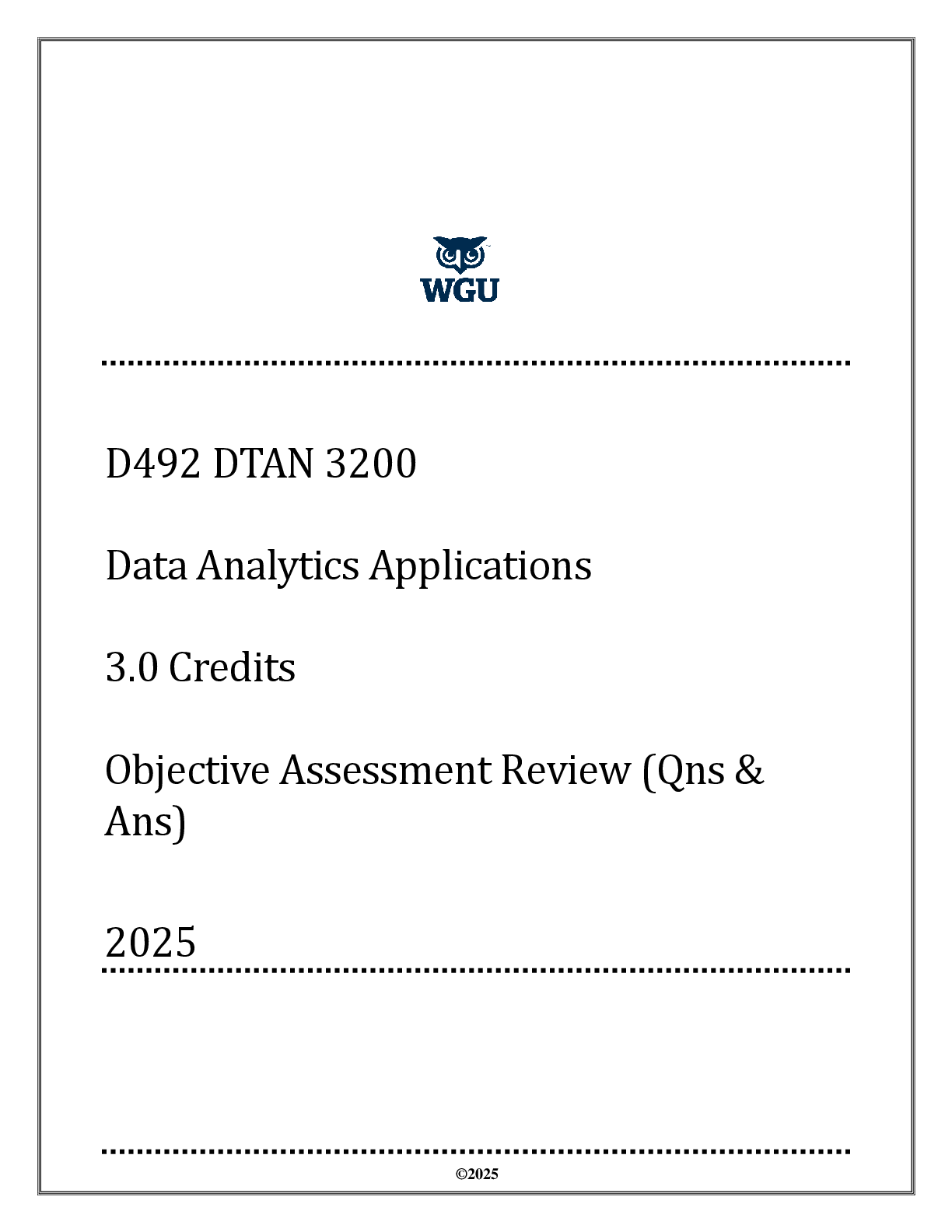
 ANSWERS.png)

 (1).png)
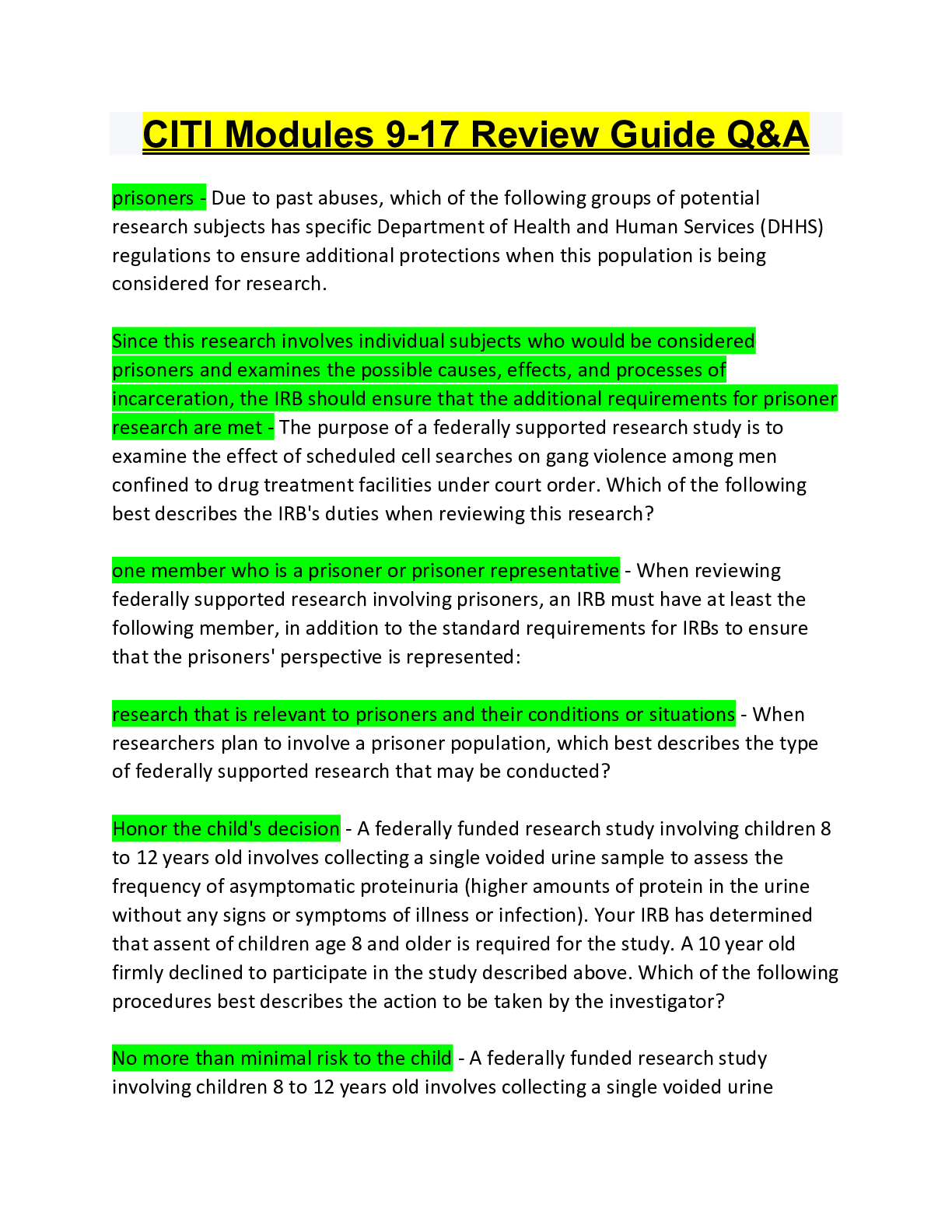





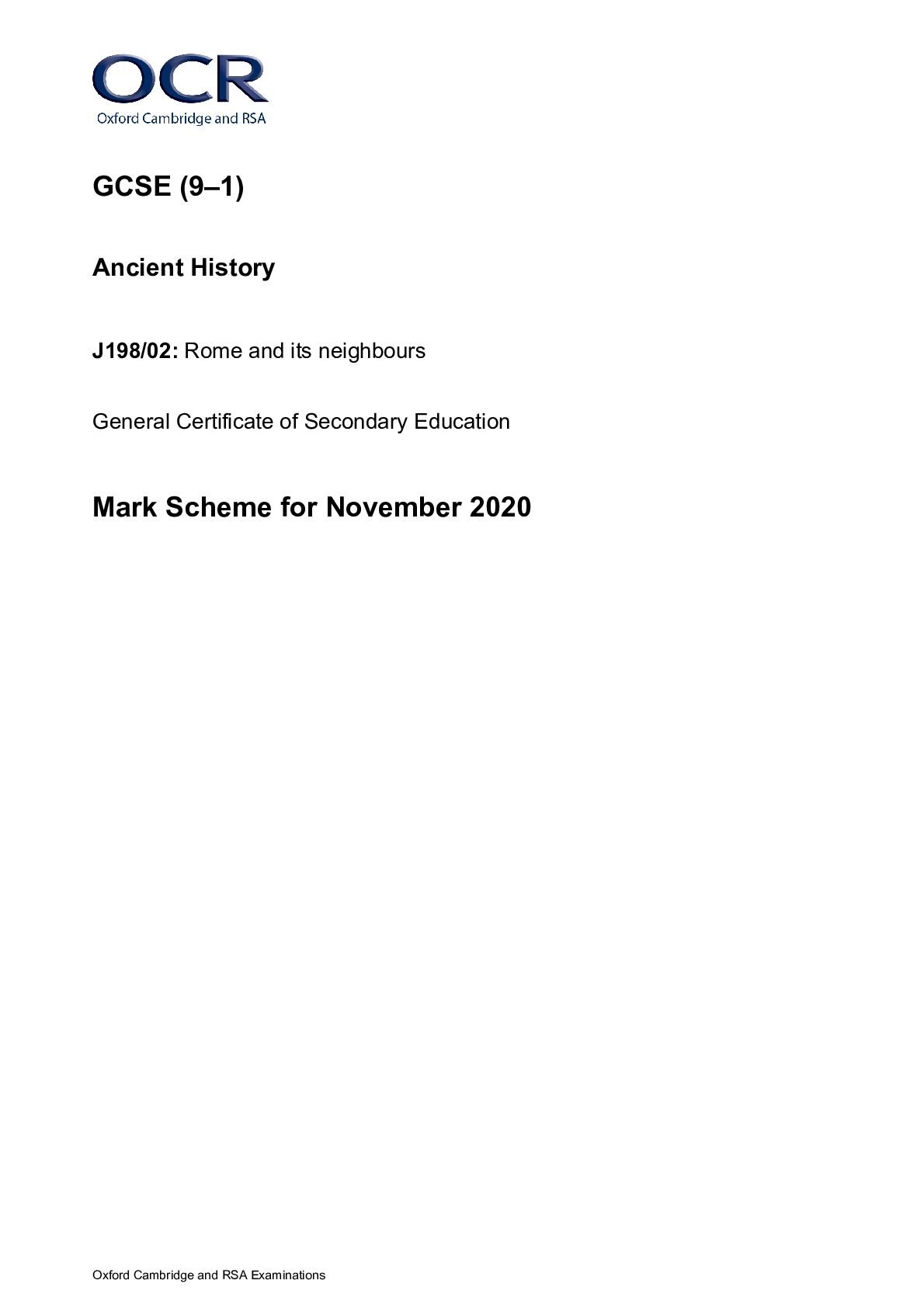








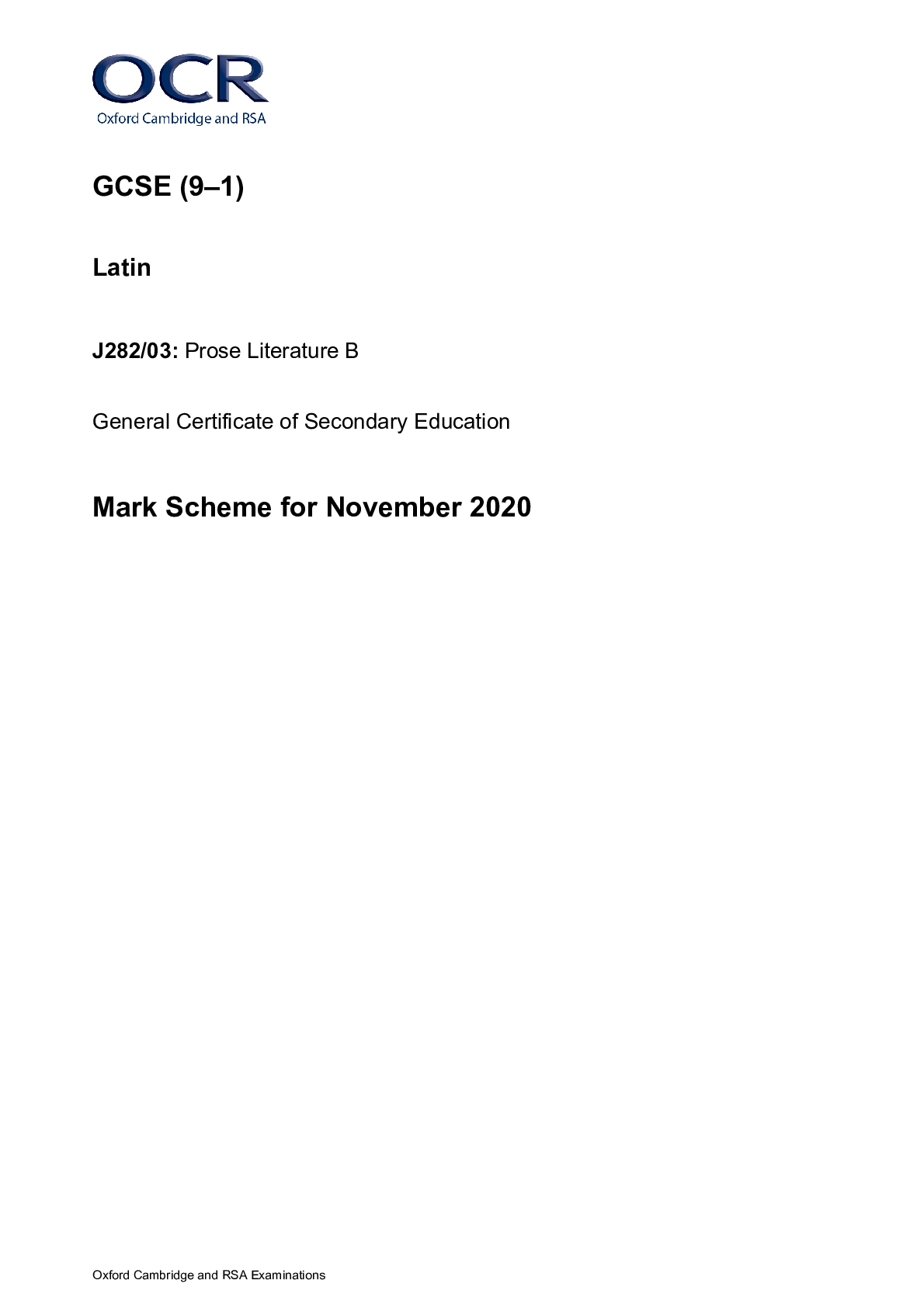

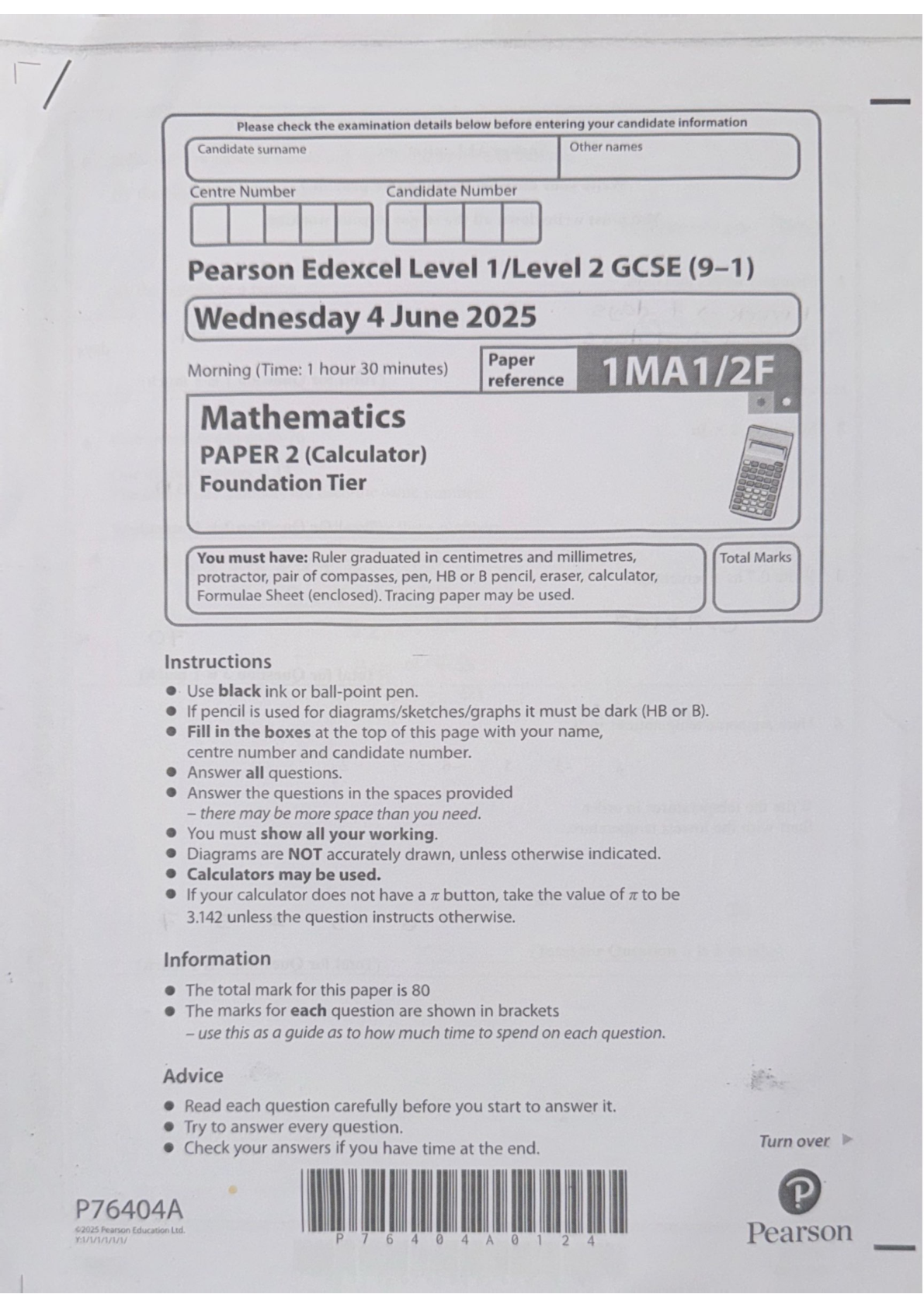

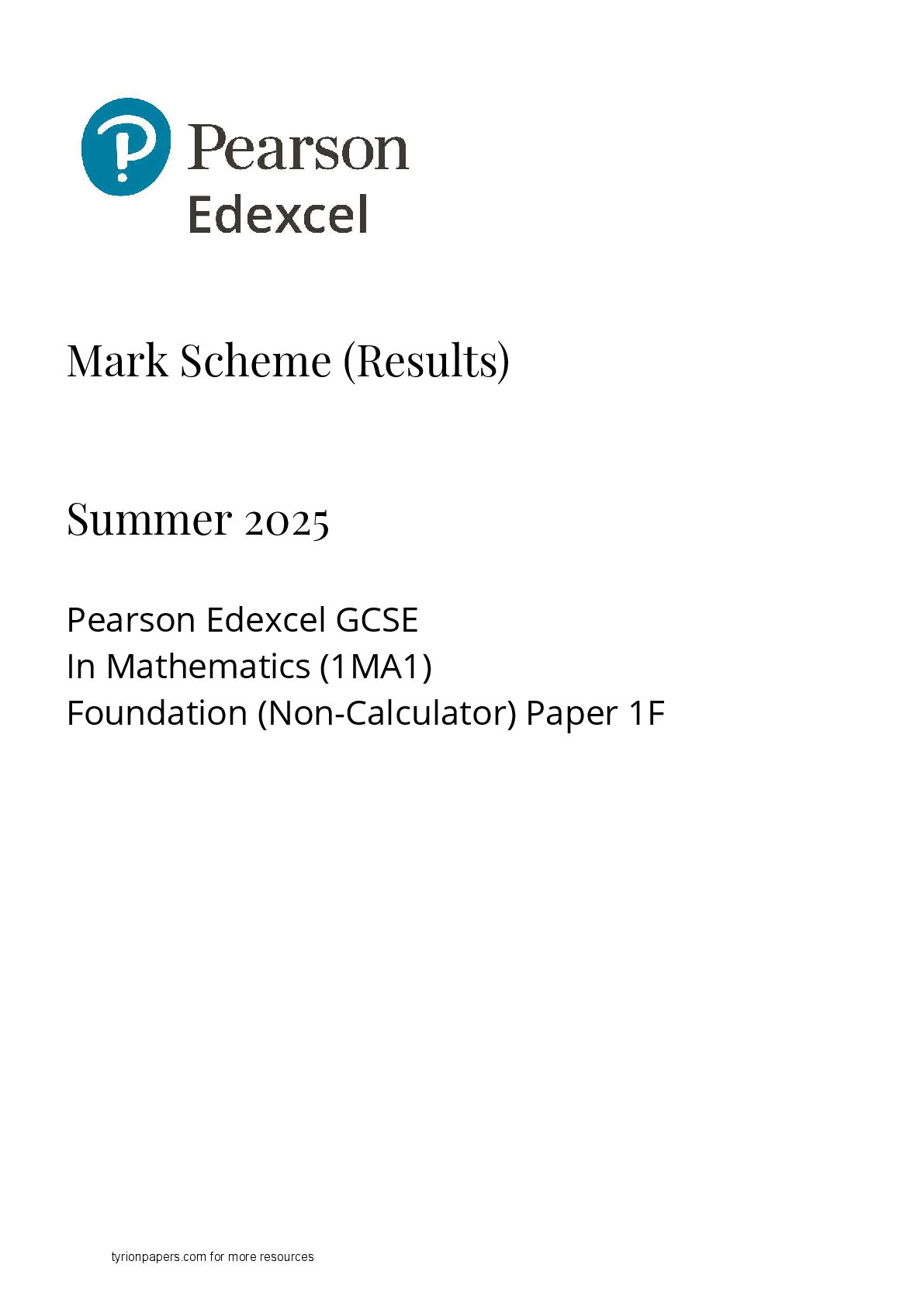
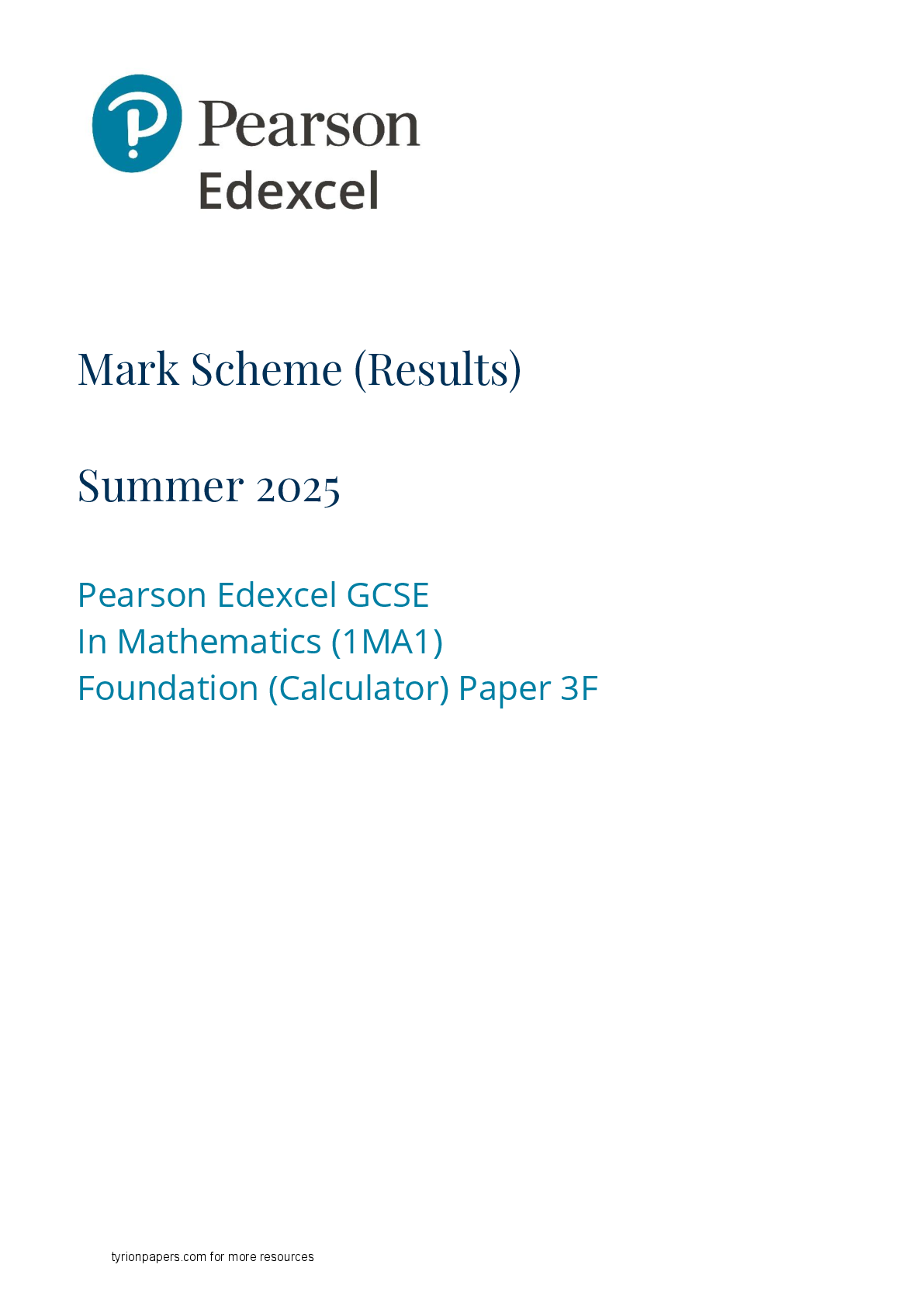


.png)
.png)
.png)
.png)
.png)

